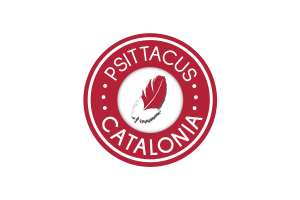PROYECTO
PYRRHURA
MOLINAE
PYRRHURA
MOLINAE
Desarrollo de nuevos protocolos de incubación artificial y cría manual para Pyrrhura molinae
ÁMBITO DEL PROYECTO: Avicultura y conservación
ENTIDADES COLABORADORAS
LUGAR DE REALIZACIÓN DEL
PROYECTO
PROYECTO
PROPUESTA
Marzo de 2022
Marzo de 2022
Sede de Psittacus Catalonia en Sant Antoni de Vilamajor. Instalación de nursería dedicada a proyectos de la Fundación
PUBLICACIÓN
(pendiente)
(pendiente)
LUGAR DE REALIZACIÓN DEL PROYECTO
Sede de Psittacus Catalonia en Sant Antoni de Vilamajor. Instalación de nursería dedicada a proyectos de la Fundación
PROPUESTA
Marzo de 2022
Marzo de 2022
PUBLICACIÓN
(pendiente)
(pendiente)
ESTADO DEL PROYECTO
ESTADO DEL PROYECTO
1
Proposta a confirmar
2
Anàlisis preliminars
3
Planificació i disseny
4
Realització
5
Anàlisi i interpretació de resultats
6
Publicació de resultats
1
Propuesta a confirmar
2
Análisis preliminares
3
Planificación y diseño
4
Realizacións
5
Análisis e interpretación de resultados
6
Publicación de resultados
ANTECEDENTES
La cotorrilla de Mejilla Verde es una especie cada vez más común como mascota. Esto hace que su cría en cautividad sea cada vez más importante.
En general los criadores dejan que los progenitores lleven a cabo el proceso de incubación y como mínimo la primera semana de cría de los polluelos.
Sin embargo, tal y como ocurre con la mayoría de especies, la definición de óptimos protocolos de incubación artificial y cría manual desde el primer día, resulta fundamental. Estas dos técnicas complementarias permiten salvar multitud de huevos fértiles y potenciar la productividad de las parejas reproductoras.
OBJETIVOS
Este proyecto pretende definir los protocolos de incubación artificial y de cría manual para esta especie. En especial pretende dar solución a la dificultad que supone la cría manual de esta especie desde edades tempranas.
RESULTADOS ESPERADOS
- Maximización del porcentaje de eclosión de los huevos fértiles
- Maximización del porcentaje de viabilidad de los polluelos nacidos
- Maximización de los ratios de crecimiento, calidad del emplume y talla final
PLANTEAMIENTO
Para el estudio, se cuenta con los huevos proporcionados por el centro de cría «Ocells.net» y que son extraidos de los nidos el mismo día de la puesta. La herramienta básica para la definición del nuevo protocolo de incubación artificial son las incubadoras DISRUPTIVE de Psittacus Catalonia. Así mismo, se utilizan prototipos de criadora DISRUPTIVE para las primeras fases de desarrollo de los polluelos. Los polluelos se alimentan en base a dos papillas de la marca PSITTACUS: Frugivorous Psittacine Crop Milk durante los primeros días de vida y Parrot Hand Feeding Fórmula en adelante.
VALORACIÓN GENERAL
Los datos obtenidos en 2022 se consideren insuficientes y se opta por continuar el estudio el 2023.
